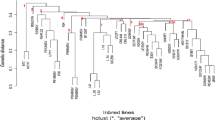Abstract
European flint maize (Zea mays L.)cannot be considered an uniform group of germplasm based on its origin and area of adaptation. However, maize breeders have not taken full advantage of the variability within the European flint germplasm. The objective of this work was to study the heterotic relationships among European maize inbreds from different origins. Nine European flint inbreds were crossed in a diallel that was evaluated in three environments in northwestern Spain. The variability within the European flint germplasm and the agronomic value of some inbreds could be utilized for maize breeding programs as an alternative to the systematic introduction of U.S. dent germplasm that is narrowing the germplasm base of breeding programs even in places where it is poorly adapted. Some European flint inbreds may also be valuable sources of earliness (F7 and EP42), resistance to root lodging (EA1070), and yield (EP42).These results suggest that, within the European flint germplasm, there could be some heterotic patterns, such as ‘north-central Europe × southern Europe’, which could provide an alternative to the heterotic pattern ‘European flint × U.S. dent’.
Similar content being viewed by others
References
Burow, M.D. & J.G. Coors, 1994. Diallel: A microcomputer program for the simulation and analysis of diallel crosses. Agron J 86: 154–158.
Cartea, M.E., P. Revilla, A. Butrón, R.A. Malvar & A. Ordás, 1999. Do second cycle maize inbreds preserve the heterotic group European flint? Crop Sci 39: 1060–1064.
Garay, G., E. Igartua & A. Álvarez, 1996a. Response to S1 selection in flint and dent synthetic maize populations. Crop Sci 36: 1129–1134.
Garay, G., E. Igartua & A. Álvarez, 1996b. Combining ability associated with S1 selection in two maize synthetics. Maydica 41: 263–269.
Griffing, B., 1956. Concept of general and specific combining ability in relation to diallel crossing systems. Aust J Biol Sci 9: 463–493.
LeClerg, E.L., 1966. Significance of experimental design in plant breeding. In: K.J. Frey (Ed.), Plant Breeding. The Iowa State University Press, Ames, Iowa. U.S.A.
Messmer, M.M., A.E. Melchinger, J. Boppenmaier, E. Brunklaus-Jung & R.G. Herrmann, 1992. Relationship among early European maize inbreds: I. Genetic diversity among flint and dent lines revealed by RFLPs. Crop Sci 32: 1301–1309.
Messmer, M.M., A.E. Melchinger, R.G. Herrmann & J. Boppenmaier, 1993. Relationship among early European maize inbreds: II. Comparison of pedigree and RFLP data. Crop Sci 33: 944–950.
Misevic, D., 1989. Heterotic pattern among U.S. Corn Belt, Yugoslavian, and exotic maize populations. Maydica 34: 353–363.
Misevic, D., 1990. Genetic analysis among maize populations representing different heterotic patterns. Crop Sci 30: 997–1001.
Moreno-González, J., 1988. Diallel crossing system in sets of flint and dent inbred lines of maize (Zea mays L.). Maydica 33: 37–49.
Moreno-González, J., F. Ramos-Gourcy & E. Losada, 1997. Breeding potential of European flint and earliness-selected U.S. Corn Belt dent maize populations. Crop Sci 37: 1475–1481.
Ordás, A., 1991. Heterosis in crosses between American and Spanish populations of maize. Crop Sci 31: 931–935.
Radovic, G. & D. Jelovac, 1995. Identification of the heterotic pattern in Yugoslav maize germplasm. Maydica 40: 223–227.
Revilla, P., P. Soengas, R.A. Malvar, M.E. Cartea & A. Ordás, 1998. Isozyme variation and historical relationships among the maize races of Spain. Maydica 43: 175–182.
SAS Institute Inc., 1989. SAS/STAT user's guide, Version 6, 4th ed., Vols. 1 and 2. SAS Institute Inc., Cary, North Carolina. U.S.A.
Sinobas, J. & I. Monteagudo, 1996. Heterotic patterns among U.S. corn belt and Spanish maize populations. Maydica 41: 143–148.
Author information
Authors and Affiliations
Rights and permissions
About this article
Cite this article
Revilla, P., Malvar, R., Cartea, M. et al. Heterotic relationships among European maize inbreds. Euphytica 126, 259–264 (2002). https://doi.org/10.1023/A:1016390107871
Issue Date:
DOI: https://doi.org/10.1023/A:1016390107871




